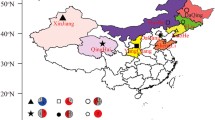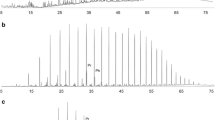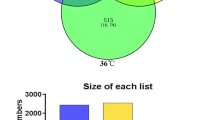Abstract
The diversity and distribution of bacterial and archaeal communities in four different water flooding oil reservoirs with different geological properties were investigated using 16S rDNA clone library construction method. Canonical correspondence analysis was used to analyze microbial community clustering and the correlation with environmental factors. The results indicated that the diversity and abundance in the bacterial communities were significantly higher than the archaeal communities, while both of them had high similarity within the communities respectively. Phylogenetic analysis showed that of compositions of bacterial communities were distinctly different both at phylum and genus level. Proteobacteria dominated in each bacterial community, ranging from 61.35 to 75.83 %, in which α-proteobacteria and γ-proteobacteria were the main groups. In comparison to bacterial communities, the compositions of archaeal communities were similar at phylum level, while varied at genus level, and the dominant population was Methanomicrobia, ranging from 65.91 to 92.74 % in the single oil reservoir. The factor that most significantly influenced the microbial communities in these reservoirs was found to be temperature. Other environmental factors also influenced the microbial communities but not significantly. It is therefore assumed that microbial communities are formed by an accumulated effect of several factors. These results are essential for understanding ecological environment of the water flooding oil reservoirs and providing scientific guidance to the performance of MEOR technology.







Similar content being viewed by others
References
Bastin E (1926) Microorganisms in oil fields. Science 63:21–24
Bernhard S (1997) Energetics of syntrophic cooperation in methanogenic degradation. Microbiol Mol Biol R 61:262–280
Birkeland NK (2004) The microbial diversity of deep subsurface oil reservoirs. In: Vazquez-Duhalt R, Quintero-Ra-mirez R (eds) Petroleum biotechnology: developments and perspectives. Elsevier B.V, Amsterdam, pp 385–403
Boll MG, Fuchs G, Heider J (2002) Anaerobic oxidation of aromatic compounds and hydrocarbons. Curr Opin Chem Biol 6:604–611
Bonch-Osmolovskaya EA, Miroshnichenko ML, Lebedinsky AV, Chernyh NA, Nazina TN, Ivoilov VS, Belyaev SS, Boulygina ES, Lysov YP, Perov AN, Mirzabekov AD, Hippe H, Stackebrandt E, L’Haridon S, Jeanthon C (2003) Radioisotopic, culture-based, and oligonucleotide microchip analyses of thermophilic microbial communities in a continental hightemperature petroleum reservoir. Appl Environ Microbiol 69:6143–6151
Borsodi AK, Micsinai A, Kovács G, Tóth E, Schumann P, Kovács AL, Böddi B, Márialigeti K (2003) Pannonibacter phragmitetus gen. nov., sp. nov., a novel alkalitolerant bacterium isolated from decomposing reed rhizomes in a Hungarian soda lake. Int J Syst Evol Microbiol 53:555–561
Brown MV, Bowman JP (2001) A molecular phylogenetic survey of sea-ice microbial communities (SIMCO). FEMS Mcirobiol Ecol 35:267–275
Dahle H, Garshol F, Madsen M, Birkeland NK (2008) Microbial community structure analysis of produced water from a high-temperature North Sea oil-field. Antonie Van Leeuwenhoek 93:37–49
Dang HY, Zhang XX, Sun J, Li TG, Zhang ZN, Yang GP (2008) Diversity and spatial distribution of sediment ammonia-oxidizing crenarchaeota in response to estuarine and environmental gradients in the Changjiang Estuary and East China Sea. Microbiology 154:2084–2095
Gieg LM, Duncan KE, Suflita JM (2008) Bioenergy production via microbial conversion of residual oil to natural gas. Appl Environ Microbiol 74:3022–3029
Grabowsk A, Nercessian O, Fayolle F, Blanchet D, Jeanthon C (2005) Microbial diversity in production waters of a low-temperature biodegraded oil reservoir. FEMS Mcirobiol Ecol 54:427–443
Gray CT, Gest H (1965) Biological formation of molecular hydrogen. Science 148:186–192
Gray JP, Herwig RP (1996) Phylogenetic analysis of the bacterial communities in marine sediments. Appl Environ Microbiol 62:4049–4059
Hallmann C, Schwark L, Grice K (2008) Community dynamics of anaerobic bacteria in deep petroleum reservoirs. Nat Geosci 1:588–591
Hubert CRJ, Oldenburg TBP, Fustic M, Gray ND, Larter SR, Penn K, Rowan AK, Seshadri R, Sherry A, Swainsbury R, Voordouw G, Voordouw JK, Head IM (2012) Massive dominance of Epsilonproteobacteria in formation waters from a Canadian oil sands reservoir containing severely biodegraded oil. Environ Microbiol 14:387–404
Jackson PE (2000) Ion Chromatography in Environmental Analysis. In: Meyers RA (ed) Encyclopedia of analytical chemistry. Wiley, Chichester, pp 2779–2801
Jiang CQ, Larter SR, Noke KJ, Snowdon LR (2008) TLC–FID (Latroscan) analysis of heavy oil and tar sand samples. Org Geochem 39:1210–1214
Jones DM, Head IM, Gray ND, Adams JJ, Rowan AK, Aitken CM, Bennett B, Huang H, Brown A, Bowler BFJ, Oldenburg T, Erdmann M, Larter SR (2008) Crude-oil biodegradation via methanogenesis in subsurface petroleum reservoirs. Nature 451:176–180
Kaye JZ, Baross JA (2004) Synchronous effects of temperature, hydrostatic pressure, and salinity on growth, phospholipid profiles, and protein patterns of four Halomonas species isolated from deep-sea hydrothermal-vent and sea surface environments. Appl Environ Microbiol 70:6220–6229
Kimura M (1980) A simple method for estimating evolutionary rates of base substitutions through comparative studies of nucleotide sequences. J Mol Evol 16:111–120
Lazar I, Petrisor IG, Yen TF (2007) Microbial enhanced oil recovery (MEOR). Petrol Sci Technol 25:1353–1366
Li H, Yang SZ, Mu BZ (2007a) Phylogenetic diversity of the archaeal community in a continental high-temperature, water-flooded petroleum reservoir. Curr Microbiol 55:382–388
Li H, Yang SZ, Mu BZ, Rong ZF, Zhang J (2007b) Molecular phylogenetic diversity of the microbial community associated with a high-temperature petroleum reservoir at an offshore oilfield. FEMS Mcirobiol Ecol 60:74–84
Li H, Chen S, Mu BZ, Gu JD (2010) Molecular detection of anaerobic ammonium-oxidizing (anammox) bacteria in high temperature petroleum reservoirs. Microb Ecol 60:771–783
Magot M, Ravot G, Campaignolle X, Ollivier B, Patel BK, Fardeau ML, Thomas P, Crolet JL, Garcia JL (1997) Dethiosulfovibrio peptidovorans gen. nov., sp. nov., a new anaerobic, slightly halophilic, thiosulfate-reducing bacterium from corroding offshore oil wells. Int J Syst Bacteriol 47:818–824
Magot M, Ollivier B, Patel BK (2000) Microbiology of petroleum reservoirs. Antonie Van Leeuwenhoek 77:103–116
Muyzer G, de Waal EC, Uitterlinden AG (1993) Profiling of complex microbial population by denaturing gradient gel electrophoresis analysis of polymerase chain reaction-amplified genes coding for 16S rRNA. Appl Environ Microbiol 59:695–700
Nazina TN, Ivanova AE, Borzenkov IA, Belyaev SS, Ivanov MV (1995) Occurrence and geochemical activity of microorganisms in high-temperature water-flooded oil fields of Kazakhstan and Western Siberia. Geomicrobiol J 13:181–192
Nazina TN, Grigor’ian AA, Sue KF, Sokolova DSh, Novikova EV, Turova TP, Poltaraus AB, Beliaev SS, Ivanov MV (2002) Phylogenetic diversity of aerobic saprotrophic bacteria isolated from the daqing oil field. Microbiology 71:103–110
Nunoura T, Hirayama H, Takami H, Oida H, Nishi S, Shimamura S, Suzuki Y, Inagaki F, Takai K, Nealson KH, Horikoshi K (2005) Genetic and functional properties of uncultivated thermophilic crenarchaeotes from a subsurface gold mine as revealed by analysis of genome fragments. Environ Microbiol 7:1967–1984
Onstott TC, Hinton SM, Silver BJ, King HE Jr (2010) Coupling hydrocarbon degradation to anaerobic respiration and mineral diagenesis: theoretical constraints. Geobiology 8:69–88
Orphan VJ, Taylor LT, Hafenbradl D, Delong EF (2000) Culture-dependent and culture-independent characterization of microbial assemblages associated with high-temperature petroleum reservoirs. Appl Environ Microbiol 66:700–711
Parkes RJ, Wellsbury P, Mather ID, Cobb SJ, Cragg BA, Hornibrook ERC, Horsfield B (2007) Temperature activation of organic matter and minerals during burial has the potential to sustain the deep biosphere over geological timescales. Org Geochem 38:845–852
Ravot G, Magot M, Fardeau ML, Patel BK, Prensier G, Egan A, Garcia JL, Ollivier B (1995) Thermotoga elfii sp. nov., a novel thermophilic bacterium from an African oil-producing well. Int J Syst Bacteriol 45:308–314
Ren HY, Zhang XJ, Song ZY, Rupert W, Gao GJ, Guo SX, Zhao LP (2011) Comparison of microbial community compositions of injection and production well samples in a long-term water-flooded petroleum reservoir. PLoS One 6:e23258
Reysenbach AL, Ehringer M, Hershberger K (2000) Microbial diversity at 83 degrees C in Calcite Springs, Yellowstone National Park: another environment where the Aquificales and “Korarchaeota” coexist. Extremophiles 4:61–67
Saitou N, Nei M (1987) The neighbor-joining method: a new method for reconstructing phylogenetic trees. Mol Biol Evol 4:406–425
Salinas MB, Fardeau ML, Cayol JL, Casalot L, Patel BK, Thomas P, Garcia JL, Ollivier B (2004) Petrobacter succinatimandens gen. nov., sp. nov., a moderately thermophilic, nitrate-reducing bacterium isolated from an Australian oil well. Int J Syst Evol Microbiol 54:645–664
Sen R (2008) Biotechnology in petroleum recovery: the microbial EOR. Prog Energy Combust Sci 34:714–724
Smith DR, Doucette-Stamm LA, Deloughery C, Lee H, Dubois J, Aldredge T, Bashirzadeh R, Blakely D, Cook R, Gilbert K, Harrison D, Hoang L, Keagle P, Lumm W, Pothier B, Qiu D, Spadafora R, Vicaire R, Wang Y, Wierzbowski J, Gibson R, Jiwani N, Caruso A, Bush D, Reeve JN (1997) Complete genome sequence of Methanobacterium thermoautotrophicum deltaH: functional analysis and comparative genomics. J Bacteriol 179:7135–7155
Stackebrandt E, Goebel BM (1994) Taxonomic note: a place for DNA–DNA reassociation and 16S rRNA sequence analysis in the present species definition in bacteriology. Int J Syst Bacteriol 44:846–849
ter Braak CJF, Verdonschot PFM (1995) Canonical correspondence analysis and related multivariate methods in aquatic ecology. Aquat Sci 57:255–289
Thompson JD, Gibson TJ, Plewniak F, Jeanmougin F, Higgins DG (1997) The CLUSTAL_X windows interface: flexible strategies for multiple sequence alignment aided by quality analysis tools. Nucleic Acids Res 25:4876–4882
Varela MM, van Aken HM, Sintes E, Reinthaler T, Herndl GJ (2011) Contribution of Crenarchaeota and Bacteria to autotrophy in the North Atlantic interior. Environ Microbiol 13:1524–1533
Voordouw G (2011) Production-related petroleum microbiology: progress and prospects. Curr Opin Biotechnol 22:401–405
Wang J, Ma T, Zhao LX, Lv JH, Li GQ, Zhang H, Zhao B, Liang FL, Liu RL (2008) Monitoring exogenous and indigenous bacteria by PCR-DGGE technology during the process of microbial enhanced oil recovery. J Ind Microbiol Biotechnol 35:619–628
Widdel F, Rabus R (2001) Anaerobic biodegradation of saturated and aromatic hydrocarbons. Curr Opin Biotechnol 12:259–276
Yamane K, Hattori Y, Ohtagaki H, Fujiwara K (2011) Microbial diversity with dominance of 16S rRNA gene sequences with high GC contents at 74 and 98 °C subsurface crude oil deposits in Japan. FEMS Microbiol Ecol 76:220–235
Yannarell AC, Triplett EW (2005) Geographic and environmental sources of variation in lake bacterial community composition. Appl Environ Microbiol 71:227–239
Youssef N, Simpson DR, Duncan KE, McInerney MJ, Folmsbee M, Fincher T, Knapp RM (2007) In situ biosurfactant production by Bacillus strains injected into a limestone petroleum reservoir. Appl Environ Microbiol 73:1239–1247
Youssef N, Elshahed MS, Mclnerney MJ (2009) Microbial process in oil fields: culprits, problems, and opportunities. Adv Appl Microbiol 66:141–251
Zengler K, Richnow HH, Rossello-Mora R, Michaelis W, Widdel F (1999) Methane formation from long-chain alkanes by anaerobic microorganisms. Nature 401:266–269
Zhang F, She YH, Ma SS, Hu JM, Banat IM, Hou DJ (2010) Response of microbial community structure to microbial plugging in a mesothermic petroleum reservoir in China. Appl Microbiol Biotechnol 88:1413–1422
Acknowledgments
We thank technicians in Daqing oil field, Karamay oil field and Huabei oil field for assistance in sample collection. This work was supported by National High Technology Research and Development Program of China (2009AA063502) and National Natural Science Foundation of China (50804024).
Author information
Authors and Affiliations
Corresponding author
Rights and permissions
About this article
Cite this article
Zhao, L., Ma, T., Gao, M. et al. Characterization of microbial diversity and community in water flooding oil reservoirs in China. World J Microbiol Biotechnol 28, 3039–3052 (2012). https://doi.org/10.1007/s11274-012-1114-2
Received:
Accepted:
Published:
Issue Date:
DOI: https://doi.org/10.1007/s11274-012-1114-2




